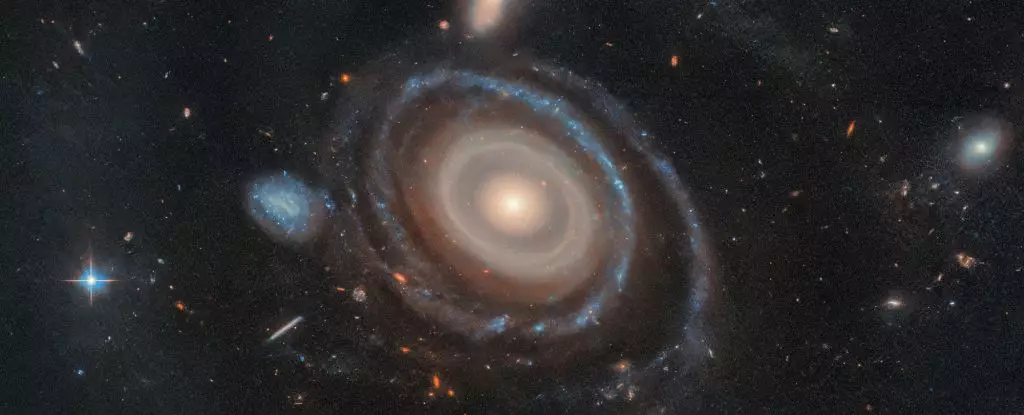In the vast expanse of our Universe, every celestial body bears its own story, etched into the cosmos as uniquely as our fingerprints and snowflakes. Recent astronomical findings have unveiled a stunning example of this uniqueness—the Bullseye Galaxy (formally designated LEDA 1313424). Situated a staggering 567 million light-years from Earth, this galaxy stands out not just for its beauty but also for its intricate structure: it boasts nine luminous concentric rings. This remarkable formation is the result of a catastrophic collision with a smaller blue dwarf galaxy that barreled through its core, setting off shockwaves that rippled through space and redefined our understanding of galaxy interactions.
An Intriguing Encounter: The Mechanism of Ring Formation
Ring galaxies are an exceptional phenomenon in our Universe, and the formation of the Bullseye Galaxy offers a rare glimpse into the dynamics of galactic collisions. These formations arise under very specific conditions, typically involving one galaxy piercing the center of another galaxy. The Bullseye Galaxy’s rings are vivid demonstrations of this process, serving as a cosmic testimony to the chaotic but fascinating dance of galaxies within the greater web of the Universe.
Astronomer Pieter van Dokkum from Yale University emphasizes the importance of this event, noting that “there’s a very narrow window after the impact when a galaxy like this would have so many rings.” Such a timeframe makes the discovery of the Bullseye Galaxy a pivotal moment for astronomers studying galactic evolution and interaction.
The findings pertaining to the Bullseye Galaxy were made possible through advanced observational technology. The use of the Hubble Space Telescope, complemented by the Keck Cosmic Web Imager (KCWI), provided astronomers with the necessary tools to analyze the structure and dynamics of this unique galaxy. In particular, KCWI, optimized for capturing visible blue wavelengths, played a crucial role in identifying the smaller companion galaxy that collided with Bullseye.
The proximity of this smaller galaxy, located roughly 130,000 kilometers (about 80,000 miles) away, was pivotal in confirming its role as the impactful “dart.” Imad Pasha, also from Yale University, underscores this significance: “We found a clear signature of gas extending between the two systems, which allowed us to confirm that this galaxy is in fact the one that flew through the center and produced these rings.”
An exciting aspect of the discovery is the gaseous connection observed between the Bullseye Galaxy and its companion. The KCWI data revealed a stream of gas forming a bridge between the two galaxies, a phenomenon that provides a concrete visualization of the interaction that took place during the collision. Van Dokkum noted the uniqueness of this observation, pointing out that it illustrates the direct physical effects of such galactic encounters—a rarity in cosmic research.
This connection between galaxies unveils a deeper narrative about the interactions that shape stellar evolution. The gas carried from one galaxy to the next contributes to stellar density variations in the resulting rings, enhancing the likelihood of star formation in those regions where material is compressed.
The concentric rings of the Bullseye Galaxy showcase regions of increased density, where galactic material has congregated due to the rippling shocks of the collision. In essence, these rings not only serve as aesthetic features of the galaxy but also as catalysts for new star formation. The brightness of these rings indicates areas rich in newly formed stars, drawing attention to the active processes at play within the galaxy.
A notable feature of this galaxy is how the rings propagate outward in nearly perfect alignment with theoretical predictions. Just like a pebble creating concentric ripples on a pond’s surface, the formation of the rings provides crucial data for astronomers to refine their models of galactic interactions and evolution.
The knowledge gleaned from the Bullseye Galaxy will undoubtedly influence current astronomical theories about galaxy collisions, offering insights that could pave the way for future studies. Researchers are optimistic that upcoming telescopes will further illuminate the realm of ring galaxies, allowing astronomers to explore how they are formed and their distribution within the cosmos.
The Bullseye Galaxy epitomizes the complexities of celestial mechanics, revealing the profound impacts of galactic collisions. With technology advancing and our understanding deepening, we remain on the brink of monumental discoveries in the vast universe—a place where each galaxy tells a unique story, waiting to be unveiled.

